Tin Pan Alley
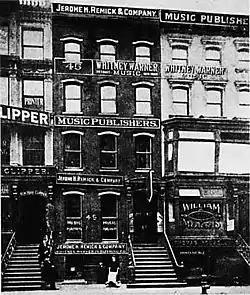
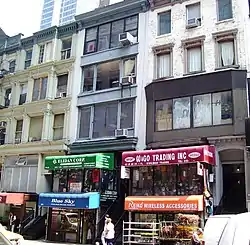
Tin Pan Alley was a collection of music publishers and songwriters in New York City that dominated the popular music of the United States in the late 19th and early 20th centuries. It originally referred to a specific place: West 28th Street between Fifth and Sixth Avenues in the Flower District[2] of Manhattan; a plaque (see below) on the sidewalk on 28th Street between Broadway and Sixth commemorates it.[3][4][5][6]
In 2019, the New York City Landmarks Preservation Commission took up the question of preserving five buildings on the north side of the street as a Tin Pan Alley Historic District.[7] The agency designated five buildings (47–55 West 28th Street) individual landmarks on December 10, 2019, after a concerted effort by the "Save Tin Pan Alley" initiative of the 29th Street Neighborhood Association.[8] Following successful protection of these landmarks, project director George Calderaro and other proponents formed the Tin Pan Alley American Popular Music Project to continue and commemorate the legacy of Tin Pan Alley with various advocacy and educational activities.
On April 2, 2022, 28th Street between Broadway and 6th Avenue was officially co-named "Tin Pan Alley" by the City of New York in a celebration featuring NYC City Councilmember Erik Bottcher, Manhattan Borough President Mark Levine and representatives from the NYC Landmarks Preservation Commission, the Flatiron/Nomad Partnership and the Tin Pan Alley American Popular Music Project which advocated for the co-naming.
The start of Tin Pan Alley is usually dated to about 1885, when a number of music publishers set up shop in the same district of Manhattan. The end of Tin Pan Alley is less clear cut. Some date it to the start of the Great Depression in the 1930s when the phonograph, radio, and motion pictures supplanted sheet music as the driving force of American popular music, while others consider Tin Pan Alley to have continued into the 1950s when earlier styles of music were upstaged by the rise of rock & roll, which was centered on the Brill Building. Brill Building songwriter Neil Sedaka described his employer as being a natural outgrowth of Tin Pan Alley, in that the older songwriters were still employed in Tin Pan Alley firms while younger songwriters such as Sedaka found work at the Brill Building.[9]
Origin of the name
Various explanations have been advanced to account for the origins of the term "Tin Pan Alley". The most popular account holds that it was originally a derogatory reference made by Monroe H. Rosenfeld in the New York Herald to the collective sound made by many "cheap upright pianos" all playing different tunes being reminiscent of the banging of tin pans in an alleyway.[10][11] However, no article by Rosenfeld that uses the term has been found.[12][13]
Simon Napier-Bell quotes an account of the origin of the name published in a 1930 book about the music business. In this version, popular songwriter Harry von Tilzer was being interviewed about the area around 28th Street and Fifth Avenue, where many music publishers had offices. Von Tilzer had modified his expensive Kindler & Collins piano by placing strips of paper down the strings to give the instrument a more percussive sound. The journalist told von Tilzer, "Your Kindler & Collins sounds exactly like a tin can. I'll call the article 'Tin Pan Alley'."[14] In any case, the name was firmly attached by the fall of 1908, when The Hampton Magazine published an article titled "Tin Pan Alley" about 28th Street.[15]
According to the Online Etymology Dictionary, "tin pan" was slang for "a decrepit piano" (1882), and the term came to mean a "hit song writing business" by 1907.[16]
With time, the nickname came to describe the American music publishing industry in general.[11] The term then spread to the United Kingdom, where "Tin Pan Alley" is also used to describe Denmark Street in London's West End.[17] In the 1920s the street became known as "Britain's Tin Pan Alley" because of its large number of music shops.[18][19]
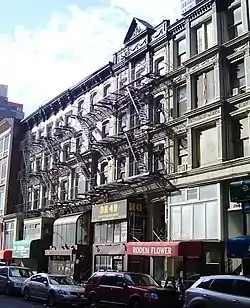
Origin of song publishing in New York City
In the mid-19th century, copyright control of melodies was not as strict, and publishers would often print their own versions of the songs popular at the time. With stronger copyright protection laws late in the century, songwriters, composers, lyricists, and publishers started working together for their mutual financial benefit. Songwriters would literally bang on the doors of Tin Pan Alley businesses to get new material.
The commercial center of the popular music publishing industry changed during the course of the 19th century, starting in Boston and moving to Philadelphia, Chicago and Cincinnati before settling in New York City under the influence of new and vigorous publishers which concentrated on vocal music. The two most enterprising New York publishers were Willis Woodard and T.B. Harms, the first companies to specialize in popular songs rather than hymns or classical music.[20] Naturally, these firms were located in the entertainment district, which, at the time, was centered on Union Square. Witmark was the first publishing house to move to West 28th Street as the entertainment district gradually shifted uptown, and by the late 1890s most publishers had followed their lead.[11]
The biggest music houses established themselves in New York City, but small local publishers – often connected with commercial printers or music stores – continued to flourish throughout the country, and there were important regional music publishing centers in Chicago, New Orleans, St. Louis, and Boston. When a tune became a significant local hit, rights to it were usually purchased from the local publisher by one of the big New York firms.
In its prime
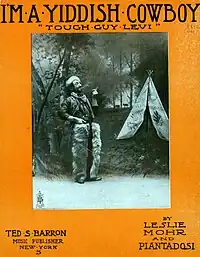
The song publishers who created Tin Pan Alley frequently had backgrounds as salesmen. Isadore Witmark previously sold water filters and Leo Feist had sold corsets. Joe Stern and Edward B. Marks had sold neckties and buttons, respectively.[21] The music houses in lower Manhattan were lively places, with a steady stream of songwriters, vaudeville and Broadway performers, musicians, and "song pluggers" coming and going.
Aspiring songwriters came to demonstrate tunes they hoped to sell. When tunes were purchased from unknowns with no previous hits, the name of someone with the firm was often added as co-composer (in order to keep a higher percentage of royalties within the firm), or all rights to the song were purchased outright for a flat fee (including rights to put someone else's name on the sheet music as the composer). An extraordinary number of Jewish East European immigrants became the music publishers and songwriters on Tin Pan Alley – the most famous being Irving Berlin. Songwriters who became established producers of successful songs were hired to be on the staff of the music houses.
"Song pluggers" were pianists and singers who represented the music publishers, making their living demonstrating songs to promote sales of sheet music. Most music stores had song pluggers on staff. Other pluggers were employed by the publishers to travel and familiarize the public with their new publications. Among the ranks of song pluggers were George Gershwin, Harry Warren, Vincent Youmans and Al Sherman. A more aggressive form of song plugging was known as "booming": it meant buying dozens of tickets for shows, infiltrating the audience and then singing the song to be plugged. At Shapiro Bernstein, Louis Bernstein recalled taking his plugging crew to cycle races at Madison Square Garden: "They had 20,000 people there, we had a pianist and a singer with a large horn. We'd sing a song to them thirty times a night. They'd cheer and yell, and we kept pounding away at them. When people walked out, they'd be singing the song. They couldn't help it."[22]
When vaudeville performers played New York City, they would often visit various Tin Pan Alley firms to find new songs for their acts. Second- and third-rate performers often paid for rights to use a new song, while famous stars were given free copies of publisher's new numbers or were paid to perform them, the publishers knowing this was valuable advertising.
Initially Tin Pan Alley specialized in melodramatic ballads and comic novelty songs, but it embraced the newly popular styles of the cakewalk and ragtime music. Later, jazz and blues were incorporated, although less completely, as Tin Pan Alley was oriented towards producing songs that amateur singers or small town bands could perform from printed music. In the 1910s and 1920s Tin Pan Alley published pop songs and dance numbers created in newly popular jazz and blues styles.
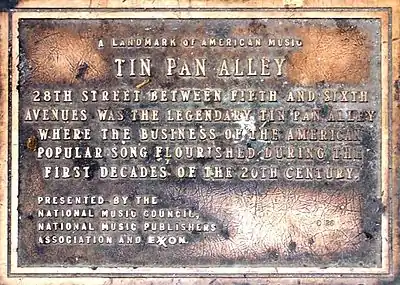
Influence on law and business
A group of Tin Pan Alley music houses formed the Music Publishers Association of the United States on June 11, 1895, and unsuccessfully lobbied the federal government in favor of the Treloar Copyright Bill, which would have changed the term of copyright for published music from 24 to 40 years, renewable for an additional 20 instead of 14 years. The bill, if enacted, would also have included music among the subject matter covered by the Manufacturing clause of the International Copyright Act of 1891.
The American Society of Composers, Authors, and Publishers (ASCAP) was founded in 1914 to aid and protect the interests of established publishers and composers. New members were only admitted with sponsorship of existing members.
The term and established business methodologies associated with Tin Pan Alley persisted into the 1960s when innovative artists like Bob Dylan helped establish new norms. Referring to the dominant conventions of music publishers of the early 20th century, "Tin Pan Alley is gone," Bob Dylan proclaimed in 1985, "I put an end to it. People can record their own songs now."[23]

Contributions to World War II
During the Second World War, Tin Pan Alley and the federal government teamed up to produce a war song that would inspire the American public to support the fight against the Axis, something they both "seemed to believe ... was vital to the war effort".[24] The Office of War Information was in charge of this project, and believed that Tin Pan Alley contained "a reservoir of talent and competence capable of influencing people's feelings and opinions" that it "might be capable of even greater influence during wartime than that of George M. Cohan's 'Over There' during World War I."[24] In the United States, the song "Over There" has been said to be the most popular and resonant patriotic song associated with World War I.[24] Due to the large fan base of Tin Pan Alley, the government believed that this sector of the music business would be far-reaching in spreading patriotic sentiments.[24]
In the United States Congress, congressmen quarreled over a proposal to exempt musicians and other entertainers from the draft in order to remain in the country to boost morale.[24] Stateside, these artists and performers were continuously using available media to promote the war effort and to demonstrate a commitment to victory.[25] However, the proposal was contested by those who strongly believed that only those who provided more substantial contributions to the war effort should benefit from any draft legislation.[24]
As the war progressed, those in charge of writing the would-be national war song began to understand that the interest of the public lay elsewhere. Since the music would take up such a large amount of airtime, it was imperative that the writing be consistent with the war message that the radio was carrying throughout the nation. In her book, God Bless America: Tin Pan Alley Goes to War, Kathleen E. R. Smith writes that "escapism seemed to be a high priority for music listeners", leading "the composers of Tin Pan Alley [to struggle] to write a war song that would appeal both to civilians and the armed forces".[24] By the end of the war, no such song had been produced that could rival hits like "Over There" from World War I.[24]
Whether or not the number of songs circulated from Tin Pan Alley between 1939 and 1945 was greater than during the First World War is still debated. In his book The Songs That Fought the War: Popular Music and the Home Front, John Bush Jones cites Jeffrey C. Livingstone as claiming that Tin Pan Alley released more songs during World War I than it did in World War II.[26] Jones, on the other hand, argues that "there is also strong documentary evidence that the output of American war-related songs during World War II was most probably unsurpassed in any other war".[26]
Composers and lyricists
Leading Tin Pan Alley composers and lyricists include:
- Milton Ager
- Thomas S. Allen
- Harold Arlen
- Ernest Ball
- Harry Barris
- Irving Berlin
- Bernard Bierman
- George Botsford
- Shelton Brooks
- Lew Brown
- Nacio Herb Brown
- Irving Caesar
- Sammy Cahn
- Hoagy Carmichael
- George M. Cohan
- Con Conrad
- J. Fred Coots
- Gussie Lord Davis
- Buddy DeSylva
- Walter Donaldson
- Paul Dresser
- Dave Dreyer
- Al Dubin
- Vernon Duke
- Dorothy Fields
- Ted Fio Rito
- Max Freedman
- Cliff Friend
- George Gershwin
- Ira Gershwin
- Oscar Hammerstein II
- E. Y. "Yip" Harburg
- Charles K. Harris
- Lorenz Hart
- Ray Henderson
- Ben Jerome
- James P. Johnson
- Isham Jones
- Scott Joplin
- Gus Kahn
- Bert Kalmar
- Jerome Kern
- Ted Koehler
- Al Lewis
- Sam M. Lewis
- Frank Loesser
- Jimmy McHugh
- F. W. Meacham
- Johnny Mercer
- Halsey K. Mohr
- Theodora Morse
- Ethelbert Nevin
- Mitchell Parish
- Bernice Petkere
- Maceo Pinkard
- Lew Pollack
- Cole Porter
- Andy Razaf
- Richard Rodgers
- Harry Ruby
- Al Sherman
- Abner Silver[27] [28]
- Lou Singer[29]
- Sunny Skylar
- Lee Orean Smith[30]
- Ted Snyder
- Kay Swift
- Edward Teschemacher
- Albert Von Tilzer
- Harry Von Tilzer
- Fats Waller
- Harry Warren
- Paul West
- Richard A. Whiting
- Harry M. Woods
- Allie Wrubel
- Jack Yellen
- Vincent Youmans
- Joe Young
- Hy Zaret[29]
Notable hit songs
Tin Pan Alley's biggest hits included:
- "A Bird in a Gilded Cage" (Harry Von Tilzer, 1900)
- "After the Ball" (Charles K. Harris, 1892)
- "Ain't She Sweet" (Jack Yellen and Milton Ager, 1927)
- "Alabama Jubilee" (Jack Yellen and George L. Cobb, 1915)
- "Alexander's Ragtime Band" (Irving Berlin, 1911)
- "All Alone" (Irving Berlin, 1924)
- "At a Georgia Campmeeting" (Kerry Mills, 1897)
- "Baby Face" (Benny Davis and Harry Akst, 1926)
- "Bill Bailey, Won't You Please Come Home" (Huey Cannon, 1902)
- "By the Light of the Silvery Moon" (Gus Edwards and Edward Madden, 1909)
- "Carolina in the Morning" (Gus Kahn and Walter Donaldson, 1922)
- "Come Josephine in My Flying Machine" (Fred Fisher and Alfred Bryan, 1910)
- "Down by the Old Mill Stream" (Tell Taylor, 1910)
- "Everybody Loves My Baby" (Spencer Williams, 1924)
- "For Sentimental Reasons" (Al Sherman, Abner Silver and Edward Heyman, 1936)
- "Give My Regards to Broadway" (George M. Cohan, 1904)
- "God Bless America" (Irving Berlin, 1918; revised 1938)
- "Happy Days Are Here Again" (Jack Yellen and Milton Ager, 1930)
- "Hearts and Flowers" (Theodore Moses Tobani, 1899)
- "Hello Ma Baby (Hello Ma Ragtime Gal)" (Emerson, Howard, and Sterling, 1899)
- "I Cried for You" (Arthur Freed and Nacio Herb Brown, 1923)
- "I'm Forever Blowing Bubbles" (John Kellette, 1919)
- "In the Baggage Coach Ahead" (Gussie L. Davis, 1896)
- "In the Good Old Summer Time" (Ren Shields and George Evans, 1902)
- "In the Shade of the Old Apple Tree" (Harry Williams and Egbert van Alstyne, 1905)
- "K-K-K-Katy" (Geoffrey O'Hara, 1918)
- "Let Me Call You Sweetheart" (Beth Slater Whitson and Leo Friedman, 1910)
- "Lindbergh (The Eagle of the U.S.A.)" (Al Sherman and Howard Johnson, 1927)
- "Lovesick Blues" (Cliff Friend and Irving Mills, 1922)
- "Mighty Lak' a Rose" (Ethelbert Nevin & Frank L. Stanton, 1901)
- "Mister Johnson, Turn Me Loose" (Ben Harney, 1896)
- "My Blue Heaven" (Walter Donaldson and George Whiting, 1927)
- "Now's the Time to Fall in Love" (Al Sherman and Al Lewis, 1931)
- "Oh, Donna Clara" (Irving Caesar, 1928)
- "Oh by Jingo!" (Albert Von Tilzer, 1919)
- "On the Banks of the Wabash, Far Away" (Paul Dresser 1897)
- "Over There" (George M. Cohan, 1917)
- "Peg o' My Heart" (Fred Fisher and Alfred Bryan, 1913)
- "Shine Little Glow Worm" (Paul Lincke and Lilla Cayley Robinson, 1907)
- "Shine on Harvest Moon" (Nora Bayes and Jack Norworth, 1908)
- "Some of These Days" (Shelton Brooks, 1911)
- "Stardust" (Hoagy Carmichael and Mitchell Parish, 1927)
- "Swanee" (George Gershwin, 1919)
- "Sweet Georgia Brown" (Maceo Pinkard, 1925)
- "Take Me Out to the Ball Game" (Albert Von Tilzer, 1908)
- "The Band Played On" (Charles B. Ward and John F. Palmer, 1895)
- "The Darktown Strutters' Ball" (Shelton Brooks, 1917)
- "The Little Lost Child" (Marks and Stern, 1894)
- "The Man Who Broke the Bank at Monte Carlo" (Charles Coborn, 1892)
- "The Sidewalks of New York" (Lawlor and Blake, 1894)
- "The Japanese Sandman" (1920)
- "There'll Be a Hot Time in the Old Town Tonight" (Joe Hayden and Theodore Mertz, 1896)
- "Warmest Baby in the Bunch" (George M. Cohan, 1896)
- "Way Down Yonder in New Orleans" (Creamer and Turner Layton, 1922)
- "Whispering" (1920)
- "Yes, We Have No Bananas" (Frank Silver and Irving Cohn, 1923)
- "You Gotta Be a Football Hero" (Al Sherman, Buddy Fields and Al Lewis, 1933)
In popular culture
- The Bob Geddins blues song "Tin Pan Alley (aka The Roughest Place in Town)", recorded by Jimmy Wilson, was a top 10 hit on the R&B chart in 1953[31] and became a popular song among West Coast blues performers.[32] The song was also covered by Stevie Ray Vaughan.
- In the 1970s to early 1980s, a Times Square bar named Tin Pan Alley, its owners, Steve d'Agroso and Maggie Smith, and many of its patrons were the real-life inspiration for the HBO series The Deuce. The bar was renamed The Hi-Hat in the series.[33]
- The song "Who Are You" by The Who has the stanza "I stretched back and I hiccupped / And looked back on my busy day / Eleven hours in the Tin Pan / God, there's got to be another way", which references a long legal meeting with music publisher Allen Klein.[34][35][36]
References
Notes
- Reublin, Rick (March 2009) "America's Music Publishing Industry: The story of Tin Pan Alley" The Parlor Songs Academy
- Dickerson, Aitlin (March 12, 2013) "'Bowery Boys' Are Amateur But Beloved New York Historians" NPR
- Mooney Jake (October 17, 2008) "City Room: Tin Pan Alley, Not So Pretty" The New York Times
- Gray, Christopher (July 13, 2003) "Streetscapes: West 28th Street, Broadway to Sixth; A Tin Pan Alley, Chockablock With Life, if Not Song" The New York Times
- Spencer, Luke J. (ndg) "The Remnants of Tin Pan Alley" Atlas Obscura
- Miller, Tom (April 8, 2016) "A Tin Pan Alley Survivor -- No. 38 West 28th Street " Daytonian in Manhattan
- "Manhattan's Tin Pan Alley could become a city landmark". am New York. March 12, 2019. Retrieved March 18, 2019.
- Staff (December 10, 2019) "LPC Designates Five Historic Buildings Associated with Tin Pan Alley" (press release) New York City Landmarks Preservation Commission
- Today's Mini-Concert - 4/14/2021
- Charlton (2011), p.3 Quote: the "term Tin Pan Alley referred to the thin, tinny tone quality of cheap upright pianos used in music publisher's offices."
- Hamm (1983), p.341
- Friedmann, Jonathan L. (2018). Musical Aesthetics: An Introduction to Concepts, Theories, and Functions. Newcastle upon Tyne: Cambridge Scholars Publishing. p. 119.
- Brackett, David (2005). The Pop, Rock, and Soul Reader: Histories and Debates. Irvington, New York: Oxford University Press. ISBN 0195125711.
- Naper-Bell, Simon, Ta-ra-ra-Boom-de-ay: The Beginning of the Music Business, (2014), p.7: quoted from Goldberg, Isaac and George Gershwin, Tin Pan Alley: A Chronicle of the American Popular Music Racket, (1930)
- Browne, Porter Emerson (October 1908) "Tin Pan Alley" The Hampton Magazine v.21, n.4, pp.455-462
- "tin pan alley" etyomonline.com, January 14, 2020
- Daley, Dan (January 8, 2004). "Pop's street of dreams". The Telegraph. London. Archived from the original on January 12, 2022. Retrieved February 23, 2011.
"We used to think of Tin Pan Alley, which is what they called Denmark Street years ago when all the music publishers were there, as rather old-fashioned," recalls Peter Asher
- "Tin Pan Alley (London)", musicpilgrimages.com, November 7, 2009
- Peter Watts. Denmark Street: London’s Street of Sounds (2023)
- Hischak, Thomas S. (ndg) "Tin Pan Alley" on Grove Music Online. Oxford Music Online/Oxford University Press
- Whitcomb, Ian (1973) After the Ball. Allen Lane, p.44
- Naper-Bell, Simon, Ta-ra-ra-Boom-de-ay: The Beginning of the Music Business, (2014), p.6
- Dwyer, Colin (October 13, 2016). "Bob Dylan, Titan Of American Music, Wins 2016 Nobel Prize In Literature". NPR.
- Smith, Kathleen E. R. (2003). God Bless America: Tin Pan Alley Goes to War. Lexington, Kentucky: University Press of Kentucky. pp. 2–6
- Hajduk, John (December 2003). "Tin Pan Alley on the March: Popular Music, World War II, and the Quest for a Great War Song". Popular Music and Society. 26 (4): 497–512. doi:10.1080/0300776032000144940. S2CID 194077544.
- John Bush Jones, God Bless America: Tin Pan Alley Goes to War (Lebanon: University Press of Kentucky, 2003), pp. 32–33
- "Abner Silver Composer Dies", The Washington Observer, Nov. 25, 1966, p. 10 Abner Silver Obituary on Google Books
- Songs composed Abner Silver on secondhandsongs.com
- "Song for Hard Times", Harvard Magazine, May–June 2009
- >Bush Jones, p. 211
- Santelli, Robert (2001). Penguin Books, p. 524
- Herzhaft, Gérard (1992). Encyclopedia of the Blues. University of Arkansas Press, p. 475
- "The Deuce: Behind the Scenes Podcast 72". The Rialto Report. September 3, 2017. Retrieved January 5, 2019.
- Perrone, Pierre (October 23, 2011) "Allen Klein: Notorious business manager for the Beatles and the Rolling Stones" The Independent
- Rosenbaum, Marty (May 21, 2019) "The True Meanings Behind The Who's Most Famous Songs: Who Are You" 93XRT
- Spray, Angie (February 11, 2015) "Who Are You and Moon's death" Rockapedia
Bibliography
- Bloom, Ken. The American Songbook: The Singers, the Songwriters, and the Songs. New York: Black Dog and Leventhal, 2005. ISBN 1-57912-448-8 OCLC 62411478
- Bush Jones, John (2015). Reinventing Dixie: Tin Pan Alley's Songs and the Creation of the Mythic South. Louisiana State University Press. ISBN 9780807159453.
- Charlton, Katherine (2011). Rock music style: a history. New York: McGraw Hill.
- Forte, Allen. Listening to Classic American Popular Songs. New Haven: Yale University Press, 2001.
- Furia, Philip (1990). The Poets of Tin Pan Alley: A History of America's Great Lyricists. ISBN 0-19-507473-4..
- Furia, Philip; Lasser, Michael (2006). The American's Songs: The Stories Behind the Songs of Broadway, Hollywood, and Tin Pan Alley. ISBN 0-415-99052-1..
- Goldberg, Isaac. Tin Pan Alley, A Chronicle of American Music. New York: Frederick Ungar, [1930], 1961.
- Hajduk, John C. "Tin Pan Alley on the March: Popular Music, World War II, and the Quest for a Great War Song." Popular Music and Society 26.4 (2003): 497–512.
- Hamm, Charles. Music in the New World. New York: Norton, 1983. ISBN 0-393-95193-6
- Jasen, David A. Tin Pan Alley: The Composers, the Songs, the Performers and Their Times. New York: Donald I. Fine, Primus, 1988. ISBN 1-55611-099-5 OCLC 18135644
- Jasen, David A., and Gene Jones. Spreadin' Rhythm Around: Black Popular Songwriters, 1880–1930. New York: Schirmer Books, 1998.
- Jones, John Bush (2015). Reinventing Dixie: Tin Pan Alley's Songs and the Creation of the Mythic South. Louisiana State University Press. ISBN 9780807159446. OCLC 894313622.
- Marks, Edward B., as told to Abbott J. Liebling. They All Sang: From Tony Pastor to Rudy Vallée. New York: Viking Press, 1934.
- Morath, Max. The NPR Curious Listener's Guide to Popular Standards. New York: Penguin Putnam, Berkley Publishing, a Perigree Book, 2002. ISBN 0399527443
- Napier-Bell, Simon (2014). Ta-ra-ra-Boom-de-ay: The Beginning of the Music Business. ISBN 978-1-78352-031-2.
- Sanjek, Russell. American Popular Music and Its Business: The First Four Hundred Years, Volume III, From 1900 to 1984. New York: Oxford University Press, 1988.
- Sanjek, Russell. From Print to Plastic: Publishing and Promoting America's Popular Music, 1900–1980. I.S.A.M. Monographs: Number 20. Brooklyn: Institute for Studies in American Music, Conservatory of Music, Brooklyn College, City University of New York, 1983.
- Smith, Kathleen E. R. God Bless America: Tin Pan Alley Goes to War. Lexington, Ky: University Press of Kentucky, 2003. ISBN 0-8131-2256-2 OCLC 50868277
- Tawa, Nicholas E. The Way to Tin Pan Alley: American Popular Song, 1866–1910. New York: Schirmer Books, 1990. ISBN 0028725417
- Whitcomb, Ian After the Ball: Pop Music from Rag to Rock. New York: Proscenium Publishers, 1986, reprint of Penguin Press, 1972. ISBN 0-671-21468-3 OCLC 628022
- Wilder, Alec. American Popular Song: The Great Innovators, 1900–1950. London: Oxford University Press, 1972.
- Zinsser, William. Easy to Remember: The Great American Songwriters and Their Songs. Jaffrey, NH: David R. Godine, 2000. ISBN 1-56792-147-7 OCLC 45080154
Further reading
- Scheurer, Timothy E., American Popular Music: The nineteenth century and Tin Pan Alley, Bowling Green State University, Popular Press, 1989 (Volume I)
- Scheurer, Timothy E., American Popular Music: The age of rock, Bowling Green State University, Popular Press, 1989 (Volume II)